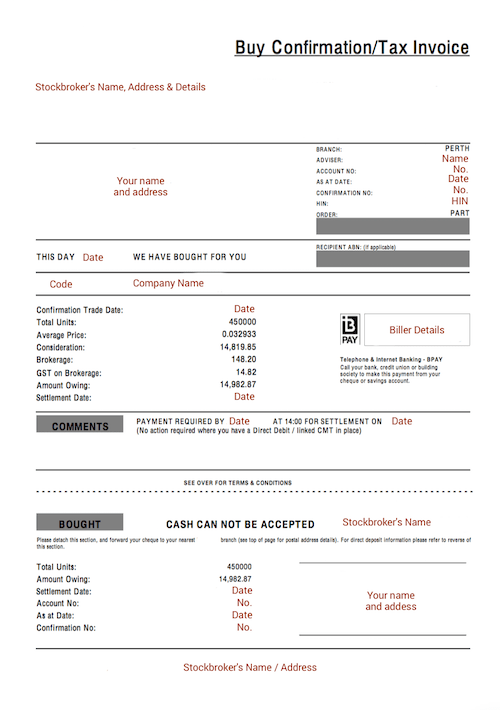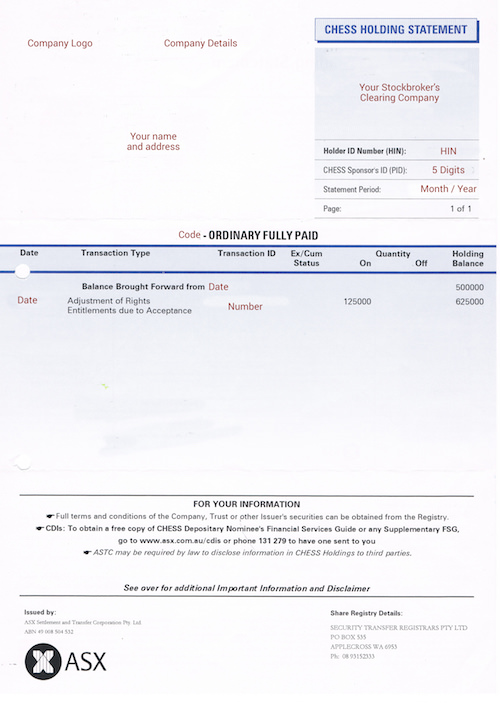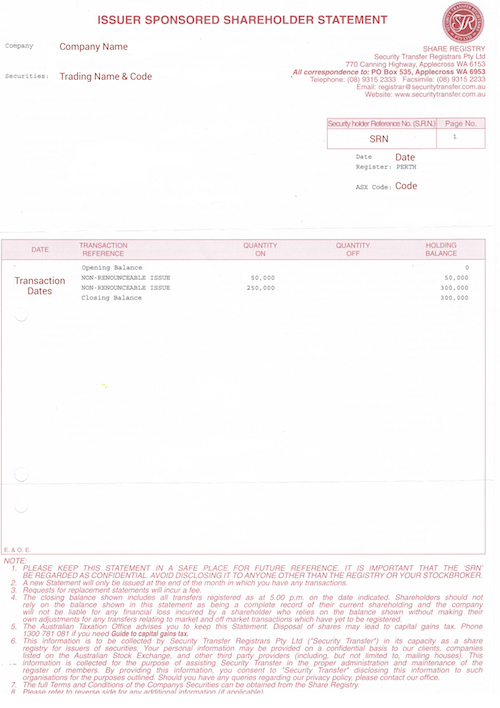How to Buy Shares in Australia
A beginners guide to buying shares on the ASX
Updated: 9 August 2022
30 SECOND SUMMARY
Setup a trading account with an ASX stockbroker. Transfer enough funds into the account to cover your share purchase and brokerage. Enter an order for the number of shares you want to buy and specify a price. Your stockbroker will email you a contract note after the transaction is complete. The funds will be deducted from your bank account two business days after the transaction.
Key Points
• Opening a trading account with your bank is the easiest option
• Minimum brokerage is ~$5 (online) vs ~$100 (full-service)
• $500 is the minimum amount of shares you can buy
• Hold your shares on HIN
• The ASX is open 10am - 4pm (AEST), Monday to Friday.
• Don't blindly trust analysts advice
• Consider investing in an Index Fund
PART ONE
How the Stock Market Works
What is the stock market?
The stock market (a.k.a. share market or stock exchange) is where people buy and sell shares in listed (public) companies. A stockbroker places all trades electronically and share settlement (ownership change) occurs two business days after the transaction.
The Australian Securities Exchange (ASX) is the largest in Australia and contains approximately 2,300 companies with a total market capitalisation over $2 trillion (AUD).
Why do companies list on an exchange?
Companies "go public” and list on an exchange to raise money for growth and expansion. They accomplish this by selling shares to investors in an Initial Public Offering (IPO) or “float".
Purchasing shares in a company buys you part ownership. You're given the right to vote on who manages the company and receive a portion of company profits through the distribution of dividends.
Note: Shares are also referred to as stocks, equities and securities.
Example of the Listing Process
Joe Bloggs Mining Pty Ltd is a privately owned company that owns a gold mine suspected of containing a significant amount of gold. Unfortunately, the company doesn’t have access to enough money to extract the gold, so the directors decide to raise funds by listing on the ASX.
The directors create a prospectus (a document detailing all aspects of the company) and distribute it to potential investors.
Simon, an investor, reads the prospectus and believes the company’s mine will produce a lot of gold, so he buys shares in their IPO in exchange for shares (part ownership) of the company.
After Joe Bloggs Mining Pty Ltd goes public, Simon, or any other investor can openly trade the company’s shares on the ASX.
Joe Bloggs Mining Pty Ltd hit gold and the value of the company increased significantly. Simon then sold his shares for a profit.
How do investors make money?
People make money from owning shares in two ways:
1. Capital Return
If you buy 1,000 shares in a company at $10 and sell them at a later date for $15, you have made a profit of $5 per share, or $5,000 (1,000 x $5).
Individuals who own shares for longer than 365 days only pay Capital Gains Tax (CGT) on 50% of the profit.
2. Dividends
Some companies will pay out profits to investors as dividends. This is a cash payment that's generally made once or twice a year to all shareholders. The amount you receive is directly proportional to the number of shares you own.
What type of “shares” can you buy?
Fully Paid Ordinary (FPO) shares are what most investors mean when they refer to “shares”. Others include:
Options
An option gives you the “option” or “right” to buy a share at a later date for a specified price. As you don't actually own shares in the company, you have no voting rights and you don’t receive dividends.
All options have an expiry date and if you don’t convert the options to FPO shares by the expiry date they become worthless. The code for many options is simply the letter “O” appended to the end of a ticker code.
Managed Funds / Exchange Traded Funds
Managed Funds and Exchange Traded Funds (e.g. VAS) are popular due to Australia's Superannuation requirements and they allow share traders to reduce their risk.
Different Ways to Buy Shares
The most common way to purchase shares is "On Market" i.e. buying them on an exchange. There are two primary Australian exchanges; The ASX and CHi-X. When you place a trade with your broker they will automatically purchase your shares at the best available price (from either exchange). Other ways include:
Initial Public Offering (IPO)
An IPO is when a private company lists (i.e. "floats") on a stock exchange to raise funds by selling shares in the company to the public.
Off Market Transfer
An off market transfer is a private sale normally done between family members or when dealing with deceased estates. No broker is required.
Capital Raising
A capital raising involves a listed company issuing additional shares to current shareholders or Sophisticated Investors to raise funds. The offered price is usually at a discount to current market value to entice investors to take part in the raising.
Managed Fund or Exchange Traded Fund (ETF)
You can buy shares indirectly by purchasing units in a Managed Fund or ETF. This method allows investors to gain exposure to a portfolio of shares in one transaction.
Employee Share Scheme
Some listed companies allow their employees to purchase shares in the company at a discount to the current market price. These transactions do not go through a stockbroker and therefore don't involve brokerage fees.

PART TWO
The Process of Buying & Selling Shares
The Steps
1. Select a stock broker
There are two types of stockbroker to choose from:
ONLINE
E.g. NAB Trade, Commsec and Bell Direct
An online broker is the cheapest and most popular option for mum and dad investors with brokerage starting at around $5 per trade.
Online stockbrokers are considered "execution only" and do not provide specific advice on what shares to buy or sell (although they provide access to company research and recommendations). You are required to place the trade yourself and know exactly which shares you want to buy and what price to pay.
Conclusion: The “Big Four” Australian banks all offer a broking service so that’s often the best place to start your research.

FULL-SERVICE
E.g. Patersons Securities, EurozHartleys and Ord Minnett
A full service stockbroker will assist you in filling out all paperwork, provide advice on what shares to buy or sell, and place the trades on your behalf.
Brokerage usually starts at around $100 per trade which can have a significant impact on your portfolio if you don’t have a large amount of capital invested.
It's often easiest to select a stockbroker in your city to allow face-to-face meetings and the completion of paperwork.
| Stockbroker Type | Online | Full-Service |
|---|---|---|
| Ease of setup | Moderate | Easy |
| Minimum brokerage | $5 - $20 | ~ $100 |
| Access to company research | Yes | Yes |
| Online tools (charting etc.) | Good | Often limited |
| Personal advice | No | Yes |
| Place trades online | Yes | No |
| Place trades by phone | Some | Yes |
2. Create the account
Your chosen stockbroker will send you the required documents via email or post.
Three points to decide prior to completing the paperwork are:
1. Entity
Which entity will own the shares (i.e. will you purchase the shares as an individual, a company or via a trust). You can also purchase shares on behalf of a minor.
2. Bank Account
Most stockbrokers require a bank account to be linked to your share trading account (with cleared funds) to pay for all purchases and to deposit the proceeds of share sales and dividends.
It’s generally wise to have a bank account specific for your share trading to prevent mixed use of your investment funds and make tax time less of a burden. Online stockbrokers will often request you setup a specific share trading bank account with them.
3. Holding the shares
Shares are held on an electronic register and not on paper. All listed companies have a share registry (an external company) that’s in charge of maintaining their constantly changing list of all shareholders. You have two choices:
CHOICE #1: Hold the Shares via your Stockbroker (HIN)
You are given a 10 digit Holder Identification Number (HIN) that begins with an “X”. This number represents all your share holdings at that specific stockbroker and is documented in the CHESS register, which is used by the ASX to confirm holdings.
If you use multiple stockbrokers you will receive a different HIN from each stockbroker. You maintain 100% ownership of the shares and they are protected in the event your stockbroker goes bankrupt. Shares can be sold instantly because your stockbroker can confirm your exact holdings.
CHOICE #2: Hold the Shares directly with the Share Registry (SRN)
You are given a 10 or 11 digit Security Reference Number (SRN) that starts with an “I”. This represents your share holdings in that specific company.
If you own shares in multiple listed companies, each share holding will be represented by a different SRN. To confirm your share holdings you must log into the applicable share registries' website (e.g. Computershare, Link Market Services, etc.) using your personal details and SRN.
To sell your shares you must quote the SRN to your stockbroker so they can double check your holdings with the registry.
Unless you know what you're doing, it's strongly recommended to hold your shares on a HIN.
FAQs
Found an old Share Holding Statement?
You can determine exactly who holds your shares, the quantity and current market value in just a couple of minutes.
Look for the SRN / HIN at the top of the page.
• Find the company using search box (top right corner of this website).
• Scroll down to "Corporate Details"
• Locate the “Registry" name
Visit the Share Registries website and login using your SRN/HIN, Name and Post Code.
Have Shares held on HIN and don’t know who the broker is?
The Participation Identification (PID) number is the I.D. of the broker holding the shares. Google this number to identify the name of the broking firm.
3. Share Selection
Most investors will fall into one of the below categories when deciding which shares to buy.
Fundamental Analysis
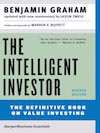
Fundamental Analysis involves the scrutiny of a company’s financial statements to determine the intrinsic (fair value) of a share price. It takes into consideration current financials (e.g. PE Ratio, Dividend Yield, future growth (e.g. EPS Growth), the evaluation of management and their business decisions. If a company's current share price is less than fair value then it’s considered undervalued and potentially worth purchasing.
Technical Analysis
Technical Analysis involves the study of past market data (primarily share price and volume) to predict future price movements. The theory is that share prices establish repetitive patterns and these can be found by overlaying indicators and trend lines to a chart.
Analyst / Stockbroker Research
All stockbrokers have a dedicated in-house team of analysts or access to an external research company. A majority of the research is based on fundamental analysis with quantitative analysis playing only a minor role. Most research reports will provide a clear buy, hold or sell recommendation.
Market Index compiles Australian broker consensus data every month.
Index Funds

Index Funds aim to replicate the movement of an index (e.g. S&P/ASX 200) and charge a small fee for the service. By purchasing shares in a index fund you can expect a portfolio return very close to the underlying index. Your investment success won’t be stock specific (as you will be exposed to all the indices constituents) but instead dependent on the movement of the market as a whole.
One of the largest Index Funds on the ASX is Vanguard's Australian Shares (VAS) ETF which provides exposure to the 300 largest companies on the ASX.
4. ASX Opening Times
The ASX is open from 10am to 4pm (AEST), Monday to Friday.
However, it’s possible to add, cancel and amend orders outside of normal hours.
| Time (AEST) | Market Status |
|---|---|
| 7am - 10am | Pre-open Trades can be entered into the system but no trading takes place. All trades are queued according to their price with priority given to trades entered first. |
| 10am | Open
Opening starts at 10:00 a.m. (Sydney) and lasts for approximately 10 minutes. Group 1 – 10:00:00 a.m. Letters A-B (e.g. ANZ) Group 2 – 10:02:15 a.m. Letters C-F (e.g. CBA) Group 3 – 10:04:30 a.m. Letters G-M (e.g. GNC) Group 4 – 10:06:45 a.m. Letters N-R (e.g. NAB) Group 5 – 10:09:00 a.m. Letters S-Z (e.g. SEK) The opening time is randomly generated and occurs up to 15 seconds either side of the times shown above. E.g. Group 1 may open at any time between 9:59:45 a.m. and 10:00:15 a.m. |
| 10am - 4pm | Normal Trading Orders are placed immediately into the market and transact as soon as volume is available at the specified price level. |
| 4pm - 4:10pm | Pre-CSPA ("Match") You can place, remove, or amend an order, but no trades actually take place. Orders (both buy and sell) are ranked according to their price. Who ever bids the highest (for buyers) or offers the lowest (for sellers) is placed at the front of the queue. Often there is a crossover in the middle (e.g. the lowest seller might offer $1.55 and the highest buyer might bid $1.63). The area in the middle where they cross over is called the “match”. |
| 4:10pm - 4:12pm | Close (Closing Single Price Auction) A random time for the close is generated by the ASX between 4:10 - 4:12 p.m. AEST. "Matching” share prices are weighted to find their mid-point and this becomes the closing price of the share. All trades that take place on the close transact at the same price regardless of what price an investor bids or offers. |
| 4:12pm - 6:50pm | Adjust Trading has stopped for the day. New trades cannot be entered into the system but stockbrokers can change or remove existing orders. |
5. How to Place the Order
This section presumes you are using an online broker.
A full-service broker should walk you through all the paperwork, provide advice and place all trades on your behalf.
Website Backend
Login to your account and ensure there is adequate funds in your linked bank account (the minimum value of shares you can buy is $500).
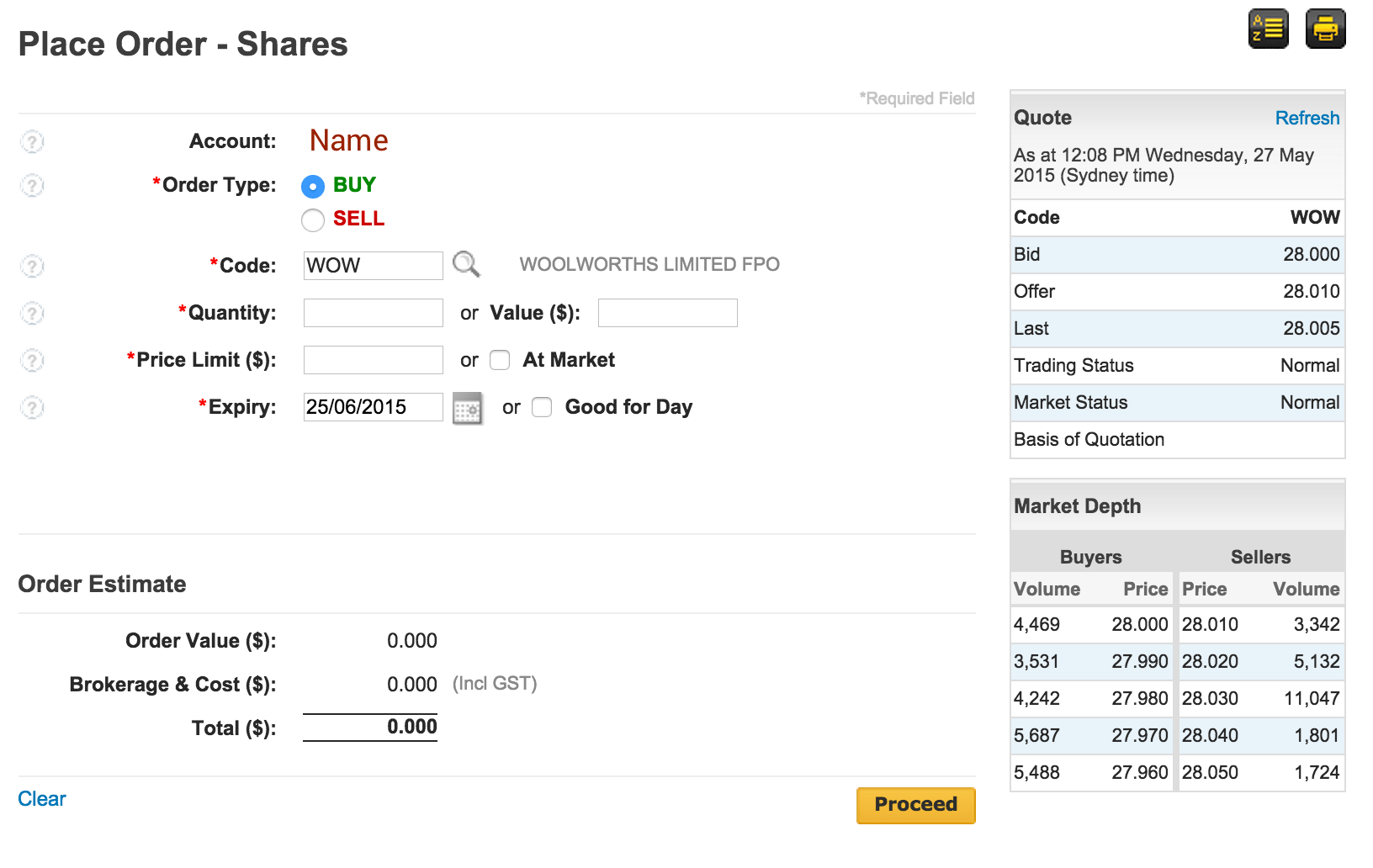 Commsec's "Place Order" Screen
Commsec's "Place Order" Screen
Order Type - buy or sell
Code - ticker symbol of the company (e.g. the Woolworths Ltd code is “WOW")
Quantity - the number or dollar value of shares
Price Limit (Limit order) - the maximum price you are will to pay per share. Your order will be placed into the queue at that specific price.
At Market (Market Order) - your shares will be purchased immediately at the best available price (i.e. the lowest seller). The price is not guaranteed and illiquid stocks may have a buy price much higher than the last traded price.
Expiry - your order will remain in the market until the date you specify when any unfilled shares in your order will be purged (removed) from the market. Some brokers use “Good till cancelled”.
Good for Day - the order will remain in the market for that current trading day only. Orders placed after market hours will expire at the end of the following trading day.
How to determine what price to pay
The Market Depth screen shows the queue of all the buyers and sellers. It’s on a "first come, first served” basis, so you are placed at the back of the queue for the price you selected.
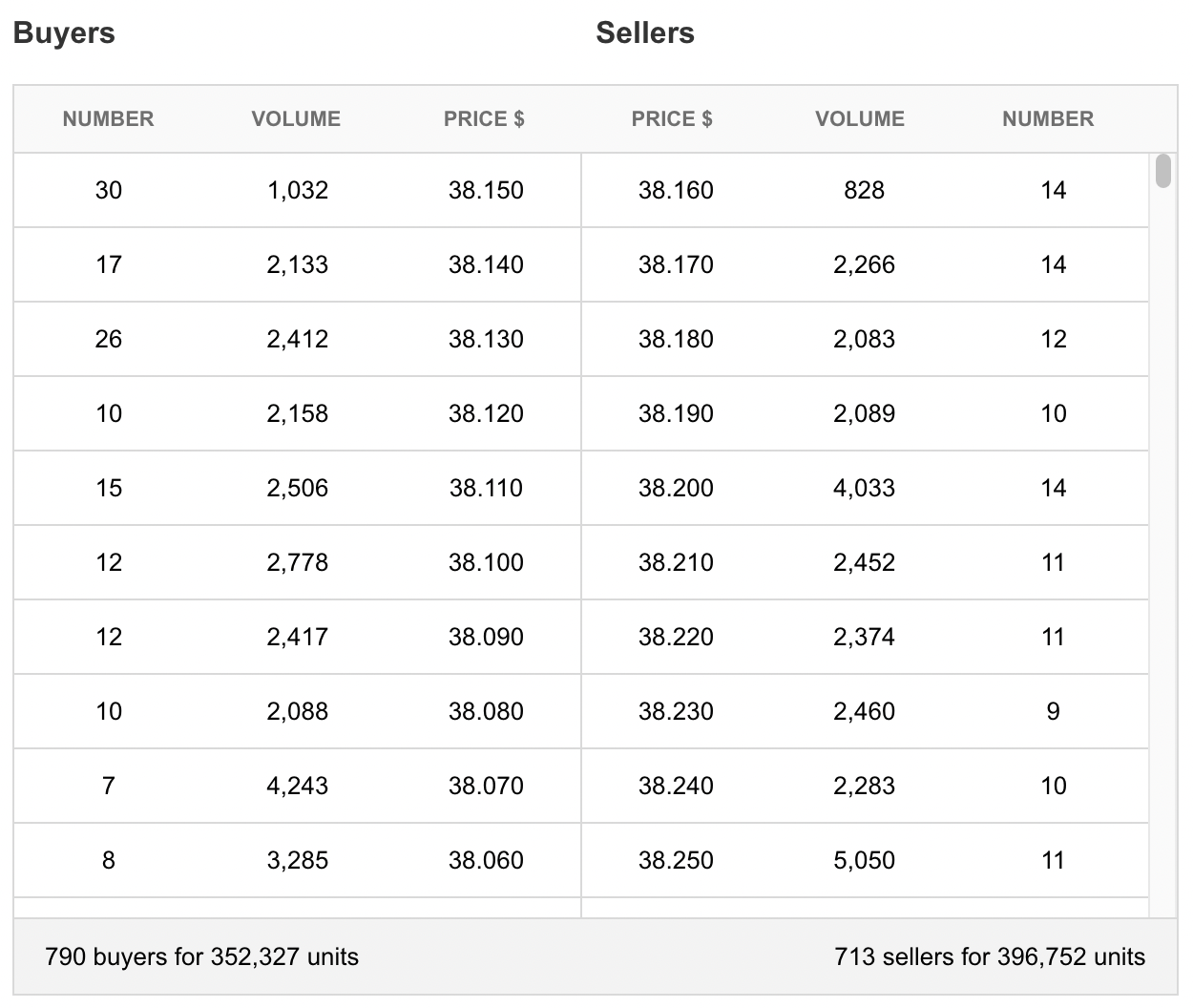
Commsec's Market Depth Screen
No. - number of orders in the queue (only displayed with some brokers)
Quantity (Volume) - number of shares available at that price
Price - price of the last trade (i.e. current share price)
In the image you can see the highest bidder (buyer) is at $38.15 (with 1,032 shares available) and the lowest seller is at $38.16 (with 828 shares available).
To purchase shares in the screen above, you could either:
1. Join the queue at any price on the buyers side and hope the share price moves down at a later date.
2. “Hit” the seller at $38.16
If you try to buy more shares than what’s available for sale at $38.16 (i.e. >828) then the unfilled shares in your order will become the first in line at a buy price of $38.16.
To guarantee your entire order is filled, you could enter a buy price higher than the lowest seller (e.g. $38.20). The transaction would buy all available shares up to your maximum number and limit price.
For example:
If you wanted to buy 1,000 shares of shares immediately, you could place a limit order at $38.20. When the trade enters the market it would purchase 828 shares at $38.16 and 172 at $38.17.
Adding Brokerage
Brokerage is the commission you pay your stockbroker for buying and selling your shares. The amount you pay is usually based on a sliding scale i.e. the larger your order, the less you pay.
Brokerage is quoted as a percentage, with a minimum value.
For example, a rate of $100 or 1.0% means you will be charged $100 for share purchase up to $10,000 and 1.0% of the total value of shares purchased for amounts greater than $10,000.
Calculating the Total Cost
| (1,000 | x | 5.00 | = | $5,000) | + | $14.95 | = | $5,014.95 |
| number of shares | share price | consideration | brokerage | total cost |
Confirmation of Transaction
After the purchase or sale of shares you receive a Contract Note via email (similar to an invoice). It's sent upon completion of the order (if all shares sold intraday) or after the market closes (if the entire order wasn’t filled).
The contract note specifies the number of shares bought or sold, amount paid and the brokerage.
6. Paying for the shares (T+2)
Share settlement (i.e. payment for shares or receiving proceeds of a sale) occurs two business days after the transaction (T+2).
On settlement day, funds will automatically be withdrawn from your linked bank account. The delay is a remnant of the "old days” when Contract Notes were sent by postal mail. It allowed time for the Contract Note to reach the buyer who then posted a cheque back to the broker.
At the end of the month you will receive documentation confirming your share holdings.
7. Monitoring your portfolio
How often you monitor your portfolio depends on your investment timeframe.
Short-term investors - monitor their holdings daily or even intraday.
Long-term investors - can choose daily, weekly or even monthly (for Index Funds). Checking intraday can overwhelm long-term investors with market “noise”, which is the random and sometimes irrational intraday movements in a share price.
What ever timeframe you use, it’s important to know three things:
1. Which COMPANY shares you own
2. NUMBER of shares owned
3. The current share PRICE (and therefore market value)
All stockbrokers provide online access to see portfolio holdings and market value (if held on HIN).
8. Selling your shares
The selling process is identical to the buying process but in reverse. Caveat - if your shares aren't held on HIN then your broker will require the SRN prior to any sale.
You will receive:
• Contract Note via email (after the trade)
• Holding Statement via post (at the end of the month)
• Net proceeds of the transaction deposited into your bank account two business days after the sale date.
9. Taxation
At tax-time you must calculate the tax payable from your share trading by tallying up your profits, losses and dividends. An added benefit of owning shares as an individual is that when you hold a share for more than a year then you only pay Capital Gains Tax (CGT) on 50% of your profit.
How to prepare your tax paperwork..
1. Broker does it - some online stockbrokers (e.g. SelfWealth) provide this for free, while most full service brokers will charge a premium for the “service”.
2. You do it - manually with pen and paper.
3. External software - ShareSight is free if you own less than 10 shares and it takes care of all dividends, reconstructions and calculations.
4. Use an excel spreadsheet
Conclusion
While the whole process appears daunting, it's pretty straight forward as soon as you've done it once.
Inexperienced investors should consider using Index Funds. Even Warren Buffet has asked for his estate to be put into an Index Fund!
On that note, I leave you with some words from the wise-man...
"My money, I should add, is where my mouth is: What I advise here is essentially identical to certain instructions I’ve laid out in my will… My advice to the trustee could not be more simple: Put 10% of the cash in short-term government bonds and 90% in a very low-cost S&P 500 index fund. (I suggest Vanguard’s.) I believe the trust’s long-term results from this policy will be superior to those attained by most investors – whether pension funds, institutions or individuals – who employ high-fee managers."
Warren Buffet
Page 20, 2013 Berkshire Annual Letter to Shareholders
Resources
Basics of the ASX - an online course that gives an overview of share market investing
Dividend Yield Investing - a beginner's guide to using the dividend yield ratio in Australia
